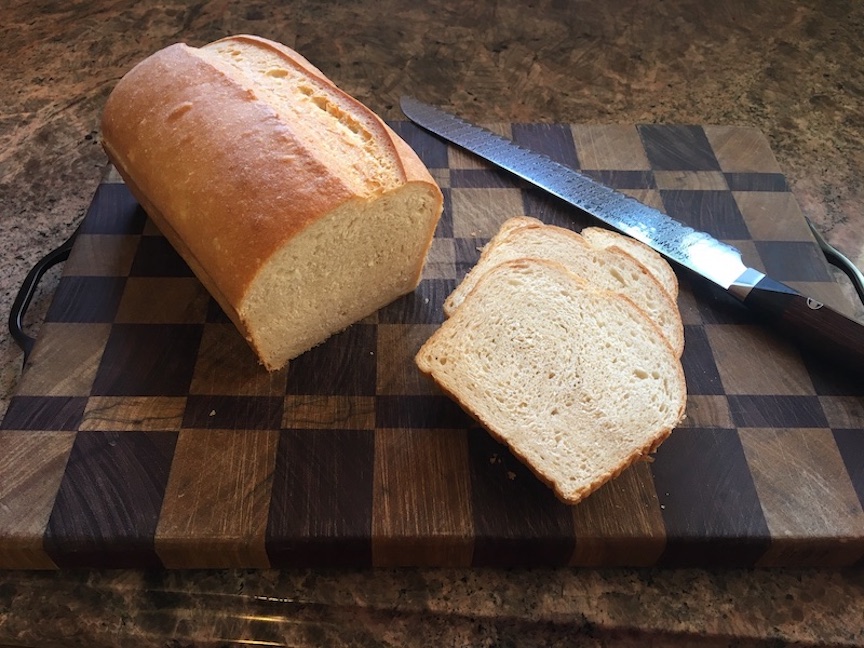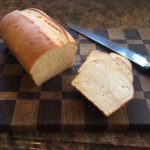This delightful and versatile classic soft sandwich bread is wonderful for sandwiches, toast or French Toast. The addition of whole wheat makes the bread more nutritious with additional vitamins and fiber.
Classic Sandwich Bread With Poolish
This delightful and versatile classic soft sandwich bread is wonderful for sandwiches, toast or French Toast. The addition of whole wheat makes the bread more nutritious with additional vitamins and fiber.
Servings 1 Makes one loaf
Equipment
- Use an 8½ inch by 4½ inch bread pan.
Ingredients
Poolish Ingredients
- 105 grams White whole wheat flour (Regular whole wheat may be used.)
- 105 grams Water, room temperature
- pinch Instant yeast
Dough Ingredients
- 210 grams Poolish, made last night.
- 280 grams Unbleached all-purpose flour
- 1 ½ tablespoon Granulated sugar
- 1 ½ teaspoon Instant yeast
- 55 grams Water (Warm 70°F/21°C-85°F/29°C)
- 115 grams Milk-Whole is best for flavor. (Warm 70°F/21°C-85°F/2/°C) (Any milk may be used.)
- 1 ½ teaspoon Salt (fine sea salt)
- 1 tablespoon Unsalted butter (Melted and cooled)
Instructions
Day Before Baking-Make Poolish
- Mix water, flour and yeast.
- Cover tightly and let rest on the counter 10-14 hours. (10 hours on warm night, 14 hours on cooler night. See Note 1.
Baking Day
- Mix the poolish, milk and water in a large bowl.
- Mix the flour, sugar and yeast in a medium size bowl.
- Add the flour mixture to the poolish mixture and mix thoroughly with one hand.
- Cover and let rest for 20 minutes. (This is the Autolyse.)
- Add the salt and melted butter and mix well.
- Knead-fold over knead 15-20 times. Cover and rest for 10 minutes.
- Knead-fold over knead 15-20 times. Cover and rest for 10 minutes.
- Knead-fold over knead 15-20 times. Cover and rest for 10 minutes.
- Knead-fold over knead 15-20 times. Place into an oiled rising container, cover and rest 50-90 minutes. Until doubled.
- Remove the dough from container and gently de-gas.
- Shape into a boule (ball), cover and let rest 10-15 minutes.
- Shape into a loaf and place seam side down into an oiled bread pan.
- Heat oven to 350°F/90.5°C
- Let loaf rise 60-85 minutes until the dome of the loaf is about 1 inch above the rim of the pan. Alternatively, depress finger into the dough, if the indention is slow to rise the bread is ready to bake. (60 minute rise on a warm day, 85 minutes on colder days.)
- Bake at 350°F/177°C for 30-40 minutes, Check after 25 minutes. Bake to thermometer reading of 195 °F
- Remove from pan and cool on a rack for 2-hours.
Note: Flavor of loaves is enhaned if not cut into until loaf is comletely cooled.
Notes
Note 1: Poolish-You want the poolish to double. If it doubles sooned than expected, you can place it into the refrigerator for up to 24 hours before making your bread.
Note 2: This bread can be made with only all purpose flour if desired. Reduce water by 1 teaspoon.



Is active dry yeast twice the amount of instant yeast?
I use the same amount of active dry yeast as I do instant yeast. Instant yeast is just a hint more powerful, but not really noticeable.
Video mentions 120g of water and flour for poolish then 105g, printed recipe shows 105g
Video shows 120g milk, printed shows 115g
Videoshows 285g flour, printed 280g
Which recipe should I use Video or printed, thanks
James
Hi James,
Good question!
The printed recipes are the updated recipes. On occasion I will improve a recipe and it will appear on the website, but not on YouTube. Once something is published on YouTube it cannot be changed. (At least I don’t know how to change it.)
Kathleen
I took up baking bread while restricted due to the pandemic. Made this loaf today and it turned out phenominal. Sent a picture to my son telling him it was my most perfect loaf yet. Procedure and directions were spot on and the YouTube video was a real help. I was perplexed that the bread was not scored before baking as I have scored every loaf made so far. I suspect this may be due to it being an enriched dough and therefore a softer crust. I did however score the top of the loaf and it turned out fine. Tremendous oven spring. This recipe is definitely a keeper for me.
I only have Active Dry yeast. Is there somewhere on your site or your videos that explains how to convert your recipes to work with ADY?
I make no difference between Active Dry Yeast and Instant yeast. Instant yeast will react a little faster than Active Dry yeast, but it a very small difference.
Hi, could you cover the grams to cups please
Thanks
Lina
My apologies for the tardiness of this response.
Flour-125 grams flour to one cup all purpose or bread flour.
120 grams whole wheat flour to one cup.
Water-240 grams water to one cup
Can I replace whole milk with a milk powder?
Yes, you can replace milk with dry milk powder. 1 Tablespoon dry milk powder equals ¼ cup milk. Replace the milk with water and then add the equivalent dry milk powder. In this recipe it would be two tablespoons dry milk powder, or more if you want more richness.
So that would be a replacement of: 115 g water and 2 tablespoons of milk powder for the recipe calling for 115 g of milk. Do I have this correct? Thanks
Yes, that is correct. A good rule of thumb with dry milk powder, is 1 tablespoon dry milk powder is equal to ¼ cup milk (60 grams).
Wonderful tutorial and recipe. Thank you.
Thank you very much!
thanks for your comments. I am very happy the bread loaves worked out for you. Bread is surprisingly forgiving.
I had never heard of Poolish before…it’s really a fun way to make bread.
Like everyone else at the beginning of the Covid, I tried my hand with Sourdough. I really got annoyed with all the ‘feeding’, and ‘discarding’ etc. This recipe seems like a bit of a compromise to all that.
Thanks for your great tutorial! Well explained and easy to follow.
My loaf turned out fantastic, and will make another one soon.
Thank you for watching! I am glad I could introduce you to poolish preferments. I use a poolish with most of my yeast bread!
Dear Kathleen,
A Google search for sandwich bread with poolish led me first to this recipe, and then to the rest of your website and YouTube channel. That was just three days ago, and you have already taught me so much. I especially love the way you explain not only the what, but the why and how. I was in the middle of another recipe, but used your shaping technique on it and the bread rose so much higher. Also, I thought I knew about the gluten web, but now I REALLY get it -thank you.
I’m going to make this poolish sandwich loaf tomorrow night and Friday. May I ask a few questions? Is it possible to substitute honey for the sugar and if so, how much? Could I increase the percentage of whole wheat flour to 50% of the total flour, and if so, would I need to make any other changes? And lastly, if I double or triple the recipe would I double or triple all ingredients?
Like so many, I’ve been baking artisan bread since 2020, but I’ve really struggled to make a good sandwich loaf. Your techniques have really helped, and I am confident this recipe is going to be “the one.” Thank you, thank you, thank you!
Thank you! I appreciate your comments! And I am very happy I could help!!
To answer your questions:
1. Yes you can add any sweetener instead of sugar. With honey, if the amount is 2 tablespoons or less you can do a direct exchange. If more than 3 tablespoons of honey, reduce the water a little. (Unless you are doubling the recipe, then an even exchange is best)
2.Yes, you can increase the percentage of whole wheat. I would also add a little more water when increasing the whole wheat as the whole wheat flour absorbs more water. I would add 1 teaspoon per 125 grams of additional whole wheat. You will know by feel if you need more.
3. When doubling or tripling of a bread recipe, no special adjusting is necessary. Simply multiply everything by 2 or 3.
Thanks a million, Kathleen! I’ll be making your wonderful bread again tomorrow and I’m going to use this additional information you provided. Now I have an additional thing to thank you for: Your kindness.
You are very welcome!
This is the sandwich bread recipe and method I have been looking for! Thank you! I made it as written and watched the video for guidance and it is just delicious. Next time I will try upping the percentage of whole wheat a little
Thank you! I am happy I could help. When adding more whole wheat flour, I would also add a little more water to the recipe. Say, add 1 teaspoon for every 125 grams of whole wheat.
Can I use bread flour in place of all purpose?
Yes, bread flour can be used in place of all purpose flour. You might want to add ½-1 teaspoon more water due to bread flour absorbing a bit more water than all purpose flour.
Awesome, thank-you!
Thank you! I am happy I could help!!
Turned out spectacular. I forgot to autolyse so I ended up proofing overnight in the fridge(made poolish in the am), it worked out fine and now I have a nice big beautiful loaf of bread cooling on the counter. Thanks again!
Hi Kathleen! thanks for the wonderfull recipe, but also the why’s ! Lots of recipes say, don’t do this, don’t do that, but nothing more. Now i know why i have to let fully cool down the bread, why i don’t add salt in the autolyse etc..
I have a question, how could you translate this recipe to machinal kneeding? I was thinking, correct me if i’m wrong.
Add poolish to water and milk in a bowl.
Add flour into machine with yeast and sugar, mix
Add wet to mixer and mix on low speed till fully incorporated
autolyse for 20 min
Add salt and oil and start machinal kneeding for 5 min ? till dough looks ready more or less.
let dough rise till doubled
bench rest 10 min
shape.
bake.
something like that?
Hi Jan, You are correct in your thinking of how to switch the recipe from hand kneading to machine kneading. The kneading time will vary depending on your machine. I suggest using the “Window pane” test to be sure your gluten is fully developed. It’s important with machines to not over knead bread as this will break down the gluten structure. 5-10 minutes kneading should do nicely.
Kathlen